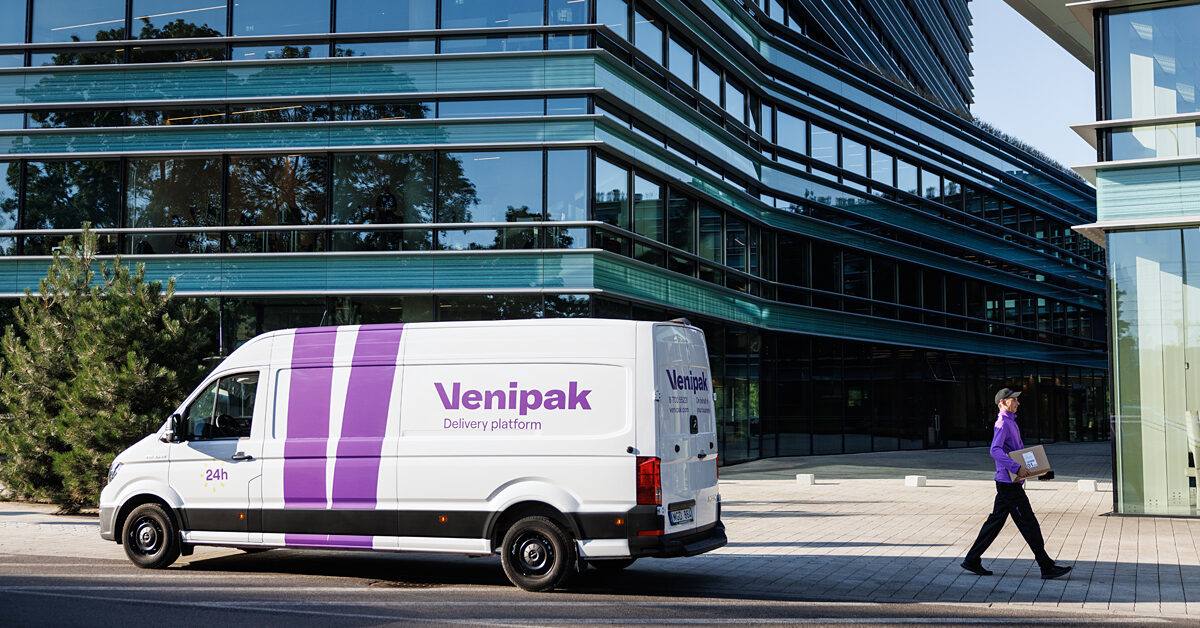Have you ever thought of becoming a courier, but you don’t know what the daily life is like and what qualities you need to have? “Venipak” courier Rolands Mertens points out that the main thing is to be punctual, to treat shipments responsibly, as well as to be polite.
Shipment delivery can be divided into several stages. It all starts with the client placing an order, and then the operator receives information that it is necessary to pick up the package. The information is given to the courier, who goes to collect it and delivers it to the warehouse, where the employee plans the route or forwards the shipment to another terminal (warehouse). After that, the package is accepted and the person responsible for logistics begins to work, dividing the received parcels by routes. The process is generally simple – client, operator, courier, logistics employee, warehouse employee, courier again and finally the client. In general, six to seven people are involved in this chain, if one or two warehouses are responsible. In the event that the process is more complicated, up to ten employees will work to deliver the package to the client.
Every morning for couriers begins with receiving tasks, where you have to plan your own route, while the computer calculates when and where exactly the package will be delivered. Of course, it is also possible to change the time, adapting to the wishes and needs of the client, so it is important to be flexible enough. Each courier’s work pace is different, as some spend more time in the warehouse to arrange their delivery vehicle, others do it faster. Also, the traffic intensity is different, so the work that is done can be evaluated individually according to different indicators.
According to R. Mertens, on average one courier delivers about 70 parcels per day, but it depends on the season. “I have also delivered 140 packages in one day, but yesterday, for example, there were 128 shipments,” explains the courier. He says that there is usually more work in the last months of the year, when various discounts are available and the holidays are approaching, but that is good. “Customers want to receive packages on time and our task is to ensure that this happens,” explains R. Mertens, adding that he does not want to face dissatisfied customers who do not receive their packages on time. Of course, there is the problem that the purchase itself is not made at the right time, for example, if it is ordered only a few days before Christmas. However, this is not the courier’s fault, but the client’s, who did not treat their shipments responsibly. It is at this time of the year that the volume of deliveries per day increases up to 140 units, so it is regularly requested to make purchases in time so that there are no misunderstandings and disappointments later.
The biggest helper in the daily work of couriers are navigation systems that help to automatically see where the necessary addresses are. Problems arise when customers have specified inaccurate addresses or postal codes, as well as when the shipment has to be delivered to relatively deep rural areas or to elderly people, because it is more difficult for them to explain which place is better to drive to and where to stop. There are no such problems in cities such as Riga or Jurmala.
When asked if there are any funny or curious incidents, R. Mertens says that sometimes there are, and the courier remembers one of them most vividly: “Once there was a case when I had to deliver an item to a beach cafe and I had to drive along the beach accordingly. It happened that I got stuck in the sand and then I had to ask vacationers for help to push the bus out of the sand. These people turned out to be tourists from Spain, who cheered me up for the whole day, when, having successfully helped, they said – uno duo and you can go! – This is how curiosities arise, but they always manage to be resolved.”
The main qualities that a good courier should possess are persistence and patience. “If you start worrying about something going wrong, then problems arise. The work of a courier takes a lot of energy, because, first of all, you have to be able to concentrate on the road while driving, you have to get out and then back into the transport several times, you have to be able to pick up and deliver the packages to the client, which tend to be heavy. You also have to follow the schedule and be punctual, reaching your destination on time. At first it is difficult, but with each passing day it becomes easier,” says R. Mertens, adding that the work of a courier is very responsible, “sometimes we don’t know what is in the package. For example, we have a client who works with cancer cells, so every package should be treated with great respect and dignity. He also explains that sometimes it is clear from the location that the shipment might contain something very important or the product is fragile, so we try to be as careful as possible.
What does R. Mertens wish for his clients? “Keep delivering with “Venipak” and to cooperation!”




